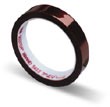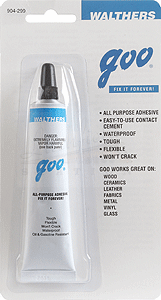Bruce has a collection of preferred adhesives.
Here is a list of what and why.
If you have other suggestions, please share them with us!

Blue painters tape from 3M is a great alternative to masking tape. This tape is wonderful for holding items in place during the installation process. It is clean and leaves no residue, as long as you remove it within a few days and it doesn't get a lot of heat. Bruce finds varying results from other manufactures' tapes and sticks with the genuine 3M product.
HINT: Bruce seriously recommends AGAINST leaving this tape in a loco for more a few days (one week?). It will be come hard to remove and leave a nasty residue over time.

Another item from the home improvement store. This thin white tape is used where thermal conductivity is needed and the tape will not see extremely high temperatures.
One place where it SHINES is in holding down decoders with an internal metal heat sink (for example the SoundTraxx Tsunami) to a metal heat sink, such as the shell of a metal loco or a metal weight in a plastic loco.

A gem from the hardware or home improvement store Is bathtub caulk. This easy-to-apply adhesive will conform to lots of variations in dimensions. It can be removed easily and is available in a clear version! It cleans up with water and has no noxious or flammable fumes.
Bruce most commonly uses PolySeam Seal, but most any of the products on the market will suffice! Acrylic caulk is all that is needed. Silicone is just a waste of money in this situation.
Bruce likes it for making speaker enclosures or attaching speakers to frames; laying track and road bed; mounting motors, etc.
HINT: Make sure to keep any adhesive off the speaker cone or surround!
A little goes a long way, so Bruce recommends the 8 ounce or so tube with the plastic cap for the most ardent user. For more casual users, find a smaller tube, if possible, or be ready to throw out a partially used tube.

HINT: Bruce does NOT recommend the white foam tape that is readily available. It degrades with time and temperature and will eventually crumble. Who wants little pieces of foam tape in the gear lube on your trucks?
He uses a foam tape made by 3-M for outdoor use. It is their product number 411, and is available at home improvement and hardware stores. It is gray with a red protective cover.
This tape is used to fill many needs:
- to hold down decoders to motors - thermal isolation is desired
- to hold down decoders and other items in locos and cars
- to hold down items where a bit of additional height is desired - the tape itself is 0.06 inches thick - multiple layers may even be used!
Here is a testimonial for "gray" tape: Bruce installed a D808 (30 amp stall current) decoder in a USA trains G-scale GP9 for a customer here in the Phoenix area. The loco ran outdoors for a year before the decoder failed for some unknown reason. The drive transistors shorted, drawing huge currents through themselves. The transistor cases were reduced to powdered plastic. The clear shrink tubing over the decoder was black from the heat. On the other side of the shrink tubing was the gray tape holding the decoder down. IT WAS UNFAISED! PERFECT, with a year's worth of outside running and a massive failure next to it

Kapton is a very good electrical insulator. It is made into a tape that is good enough for aerospace and satellite applications. Its characteristics include:
- High temperature stability - you can solder on it (800 degrees F) and not damage or distort it! Hopefully your loco will not be that hot inside. This also relates to the adhesive - it still sticks after exposure to such temperatures!
- Thin - a good insulation for the voltages found in DCC can be had with a tape only 0.001 inches (0,02 mm) thick!
- It does not have a lot of shear (tearing) or punch-through strength. Don't expect it to insulate a solder joint with the jagged end of a wire sticking out - use shrink tubing!
- When people hear installers sing the praises of Kapton tape, one of their first questions is: "Where do I get it"? Litchfield Station, amongst others!

We all know about this staple of modeling. Bruce is very happy with Faller Expert. It comes in a very easy to use bottle. It is the normal methyl-chloride styrene cement with about 10% styrene dissolved within. It makes nice fillets and rounds. It sets medium-slowly.
Hint: When we cut off a light pipe in a loco, we don't spend a lot of time polishing the end. A drop of Faller Expert on the end and you get a nice optical surface!
If you don't clear the throat of the bottle, the cement will dry in place and plug up the snout. Not fun! I like to use a piece of 0.010 phosphor bronze wire (Titchy Train Group) as a plug. Just insert it so that the wire runs through the entire snout and no more plugged snout.
Bruce's other Styrene Cement choice is MEK (Methyl Ethyl Keytone), which he buys at the home improvement or hardware store or online. It is very fast to set up and very strong as a complete styrene welder. USE WITH ADEQUATE VENTILATION! It is a minor health risk and, as such, is getting harder to find, especially in California.

Aptly named, this compliant adhesive is another mainstay of model railroading.
Bruce has used it for years.
These days, Bruce seems to use more bathtub caulk than Goo.

